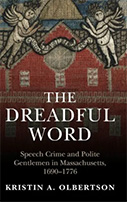The Dreadful Word: Speech Crime and Polite Gentlemen in Massachusetts, 1690–1776

Author: Kristin A. Olbertson
Publisher: Cambridge University Press, 2022. 258 pages.
Reviewer: Lyndsay Campbell | September 2022
Kristin Olbertson’s new book, The Dreadful Word: Speech Crime and Polite Gentlemen in Massachusetts, 1690–1776, draws us into the fascinating world of criminal expression from the Glorious Revolution to the American Revolution. Olbertson takes us through the records of prosecutions over speech and other kinds of vocalizations that she has found by meticulously and comprehensively combing the records of local courts, those held by justices of the peace sitting alone or in general sessions. These judges heard cases over expression that was considered threatening, rude, profane, false, fraudulent, defamatory, or simply noisy and disturbing.
By closely analyzing who mobilized the law against whom in cases concerning over 1,600 individuals prosecuted for speech or other vocalizations over this time period, Olbertson charts a shifting sense of the behavioral demands of elite masculinity, as gentility became the central consideration for self-presentation as a respectable white man entitled to a place in the ruling class (p. 5). She argues that the powerful who brought cases and served as justices of the peace construed honest, polite expression as a characteristic of gentlemen and used criminalized expression to reify class boundaries—it was lower-class and working men who predominantly found their speech legally censured. The law was used to guard ‘sensibility’ against rude expression that offended by its noisiness, abusiveness, or profanity. It was mobilized in defense of social standing, to discipline inferiors who, for example, slandered their superiors. People were prosecuted for false or fraudulent expression and for passing as gentlemen when they were not. Racism and bigotry against the non-English heavily influenced characterizations of truthfulness. However, as the revolutionary period took shape, commitments to deference in public expression failed to quell disorderly, loud expression on the streets, and of course violent and vulgar language could reflect valid political critique. In this period, concern about politically subversive expression pushed concern about impoliteness, profanity, and the rest to the side, while a new, more egalitarian ethos of respectability displaced gentility for those who sought to distinguish themselves from the vulgar (pp. 283–84). The truthfulness of news reports became disentangled from the social status of the one who relayed it.
Throughout the book, Olbertson emphasizes how strongly gendered these legal strategies were. Women were prosecuted far less often than men. Olbertson hypothesizes that as the century passed, women’s speech became less important, rather than more decorous. They were no longer feared as wielders of hexes and curses who brought evil results. Few women—and no gentlewomen—appeared as parties in criminal defamation cases. Women’s credibility, too, became increasingly suspect, as they were characterized as gossips and liars, and their childbed assertions of the paternity of their nonmarital infants were increasingly disbelieved. They were not, however, prosecuted for spreading false news, possibly because their news was not considered believable or disruptive.
The Dreadful Word yields up thought-provoking insights into anglicization in pre-revolutionary Massachusetts and how trends around self-presentation that were evident in fashion, housing, and other domains were manifest in prosecutions for expression. The Revolution marks a rupture, when the illogic in the assumption that smooth surfaces reflected virtuous interiors became impossible to sustain any longer; but at the same time Americans came to accept a measure of deception as a reasonable and necessary part of self-presentation for the respectable middle class. The cracks had always been evident, as Olbertson shows: the most adept Restoration-era courtiers were recognized as traffickers in deceit, fraudsters passed themselves off as gentlemen, gentlemen were publicly revealed to be liars, carefully crafted satire was nonetheless evidence that gentlemen did trade in defamation, and rough language was used within the walls of private clubs. Olbertson argues that during the Revolution, lawmakers’ attention shifted from the impolite to the disloyal, and when it shifted back to other speech, its emphasis had changed. “The old hierarchies of language and persons, as performed and refined in criminal speech prosecutions, were fading away, to be replaced by new conceptions of speech, status, and political authority” (p. 277). Even when statutes went unchanged, the law was applied differently, oriented more toward protecting democratic participation in the political process than shoring up class boundaries. This finding aligns with my own work on Massachusetts libel law in the next few decades, in which I found an increasing focus on truth and an aversion to privilege (Campbell, 2021). Along these lines, I did find myself with a question. The constitutionality of common law criminal libel was challenged in the early nineteenth century in Massachusetts through arguments that it had never been employed in the pre-revolutionary period. I wondered, therefore, whether any of the libel and slander prosecutions Olbertson describes were brought apart from the 1692 statute Olbertson cites, and also what happened before it. I realize, though, that these records may well not have revealed such niceties.
Through her careful and perceptive scholarship Kristin Olbertson has deepened our knowledge of law as an instrument for maintaining social, gender, and racial hierarchies in the eighteenth century.
References:
Campbell, Lyndsay. 2022. Truth and Privilege: Libel Law in Massachusetts and Nova Scotia, 1820–1840. Cambridge, UK: Cambridge University Press.
Lyndsay Campbell is a professor of law and history at the University of Calgary.


